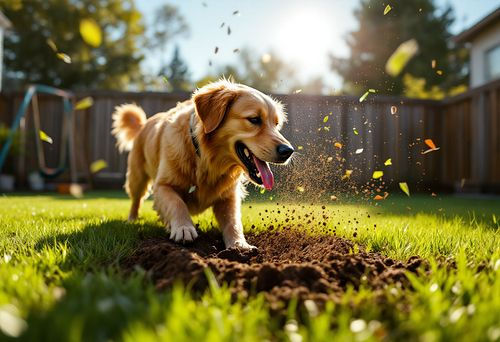Landscaping for Dog's Personalities: Work With (Not Against) Your Pup
- Robyn Cates
- 4 hours ago
- 3 min read
Every dog has an outdoor style. Some dig, some patrol, some greet every passerby like it’s their job. Instead of fighting their instincts, let’s design with them in mind. At La Madrina, we love your fur babies and always consider their interactions with our landscape designs. Here’s our advice on how to match your outdoor space to your dog’s personality—keeping your yard functional, beautiful, and pet-happy.

The Digger
Traits: Loves to excavate, especially in soft soil or garden beds
Solutions:
Designated dig zones (sandbox or mulch pit with buried toys)
Raised beds or stone borders
Gravel paths or flagstone buffers
The Patrol Officer
Traits: Paces the perimeter, guards the fence line, barks at squirrels and neighbors
Solutions:
Mulch or gravel perimeter paths
Staggered shrubs or privacy panels
Vertical scent posts (cedar stakes, boulders)
The Grass Roller
Traits: Loves to flop, roll, and nap on turf—especially after rain or grooming
Solutions:
Durable turf blends (fescue, ryegrass)
Artificial turf pads or shaded lawn zones
Graded drainage to avoid muddy wallows
The Socialite
Traits: Rushes to the gate, loves visitors, may trample plants in excitement
Solutions:
Durable greeting pad (pavers or turf)
Low fencing or hedging near walkways
Sit/stay training zones near entry
The Escape Artist
Traits: Digs under, jumps over, or squeezes through fences
Solutions:
Dig-proof fencing and double gates
Gravel trenches or buried mesh
Dense hedges or privacy screens

The Smartie
Traits: Learns fast, gets bored easily, needs stimulation
Solutions:
Agility elements, scent trails, puzzle feeders
Rotating textures and toys
Shade and shelter zones for rest
The Mud Magnet
Traits: Loves puddles, wet soil, and messy play
Solutions:
Graded drainage zones
Mud-free paths (decomposed granite, gravel)
Rinse station near entry
The Loner
Traits: Prefers quiet zones, avoids stimulation, enjoys solo lounging
Solutions:
Shaded alcoves with soft ground cover
Low-traffic layout
Calming plants (lavender, chamomile)
The Vocalist
Traits: Barks at everything—passersby, squirrels, wind
Solutions:
Dense plantings or acoustic fencing
Scent trails or puzzle distractions
Sightline blockers to trigger zones

The Toy Hoarder
Traits: Collects toys, hides them, guards favorite items
Solutions:
Outdoor toy bins or baskets
Hide-and-seek mulch beds
Seasonal toy rotation
The Mulch Eater
Traits: Snacks on bark mulch, chews wood chips, may ingest harmful materials
Solutions:
Pet-safe mulch alternatives (pea gravel, decomposed granite)
Steel or stone edging barriers
Chew-safe logs or stumps
The Plant Eater
Traits: Nibbles leaves, chews stems, may target specific textures or scents
Solutions:
Pet-safe plant palette (avoid azalea, sago palm, foxglove)
Repellent borders (rosemary, lavender, lemongrass)
Elevated planters and containers

The Shadow
Traits: Follows humans constantly, stays close, watches everything
Solutions:
Walkable companion paths
Observation perches (boulders, benches)
Soft turf or shaded patios for resting nearby
Final Thoughts
Designing a landscape that works with your dog’s personality isn’t just about protecting your plants—it’s about creating a space where both humans and pets thrive. Whether your pup is a digger, a greeter, or a mud magnet, thoughtful design can redirect their instincts, reduce wear and tear, and make your yard more enjoyable for everyone.
Start with observation: how does your dog move, rest, play, and interact with the space? Then layer in materials, zones, and plantings that support those behaviors. The result is a yard that feels intentional, resilient, and deeply personal.
Final Tips for Dog-Friendly Design
Use non-toxic materials for mulch, plants, and edging
Design for movement and stimulation—dogs need paths, zones, and visibility
Reinforce high-traffic areas with durable surfaces
Include water access—a splash zone or bowl station keeps pups hydrated
Need help translating these ideas into plans to DIY or have La Madrina install? Book a consultation with La Madrina today!



Comments